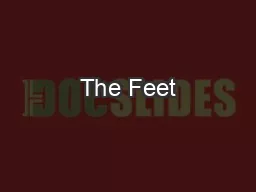

Functions of the Hoof The main functions of the hoof are to Provide a weight bearing surface Protect the sensitive internal structures of the foot Maintain moisture in the foot Provide grip Act as a shock absorber ID: 483317
Download Presentation The PPT/PDF document "The Feet" is the property of its rightful owner. Permission is granted to download and print the materials on this web site for personal, non-commercial use only, and to display it on your personal computer provided you do not modify the materials and that you retain all copyright notices contained in the materials. By downloading content from our website, you accept the terms of this agreement.
Slide1
The FeetSlide2
Functions of the Hoof
The main functions of the hoof are to:
Provide a weight bearing surfaceProtect the sensitive internal structures of the footMaintain moisture in the foot
Provide gripAct as a shock absorberSlide3
Sensitive vs Insensitive Structures
The hoof is a complex grouping of sensitive and insensitive structures which must be kept healthy and undamaged Sensitive structures
Contains many nerve and blood vesselsCoriumModified skin tissue within the footLines the hoof with each of its parts named according to the insensitive structure it underlies and producesEx. Frog corium (sensitive) lies below and produces the horny frogInsensitive structuresHorny layer structuresEx. Insensitive
laminae, periople, wall, bars, sole, and frogSlide4
External Hoof Anatomy
The external surface of the hoof consists of the:SkinCoronary band
Rim of specialized skin, includes coronary corium and blood vesselsHoof wallVisible, outer covering of horse’s footThe hoof wall is divided into regions:
The toeThe quartersThe heelSlide5
External Hoof Anatomy
Solar SurfaceSlide6
External Hoof Anatomy
Outer Hoof WallThe outermost layer of horn cells
SoleIs a thick plate of flaky horn that covers most of the ground surface and is rounded in such a way that when viewed from the bottom, it is concaveFrogIs an elastic, wedge shaped mass of horn that fills a triangular space at the back of the foot
Heel bulbsFormed by the back of the digital cushion
The ground surface (solar surface) of the hoof is composed of the
sole
,
frog
,
bulbs
, and bearing edge of the
hoof wallSlide7
Internal Hoof Anatomy
Bringing it all togetherSlide8
Internal Hoof Anatomy
The Elastic Tissues
Elastic tissues are those which are capable of changing shape in response to foot impactThe elastic tissues are:The digital cushion
The hoof wallThe sole (discussed earlier)The frog (discussed earlier)The bulbs of the heel
(discussed earlier)Slide9
Internal Hoof Anatomy
The Elastic Tissues The Digital CushionIs the main shock absorber of the hoof
Is bound by the lateral cartilages at the sides, the deep digital flexor tendon above, and the horny frog belowThe back of the cushion forms the bulbs of the heelGood vs. Bad Digital CushionSlide10
Internal Hoof Anatomy
The Elastic Tissues The Hoof WallLocated at the hairline along the top of the hoof wall is the coronary band, which is the primary source of growth and nutrition for the hoof wall
Around the perimeter of the ground surface of the hoof is the white line, which represents the inside edge of the hoof wall at it’s junction with the sole. The white line marks the border between the sensitive and insensitive sole. It serves as a guide to show where nails should be driven when shoeing the horseThe wall grows approx. 0.25 inch (6mm) per month, taking from 9 to 12 months for the toe to grow out. Growth tends to be slower in cold or dry environments Slide11
The Hoof WallSlide12
The Hoof as Shock Absorber
The shock of concussion is dissipated laterally against the hoof wall
As the foot strikes the ground, downward pressure flattens out the concave surface of the soleThis distributes weight laterally against the hoof wall, which expands about a quarter of an inch (6mm)
Hoof as a shock absorberSlide13
The Hoof as Shock Absorber
With heel pressure, the frog compresses the digital cushion, which then flattens and pushes the lateral cartilages outward in opposite directions
During concussion the navicular bone shuttles the load from the digital cushion through to the short pastern bone, bypassing the coffin bone and relieving some of its loadThe conformation of the knee and hock joints also helps reduce the shock of impactSlide14
The Hoof & Conformation
Closely related to the way it functions and to the form of the limb itselfDifferences in the front & hindFront – rounded toe & broad heelHind – Slightly narrower and more pointedMalformations of the foot may cause actual injury (breakdown of the foot structures, concussion ailments) or predispose an animal to injury (bruising, interference, cross-firing)
Shape and composition of the foot are indicators of the health and general soundness of the whole horseTools to evaluate balance